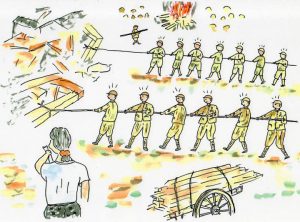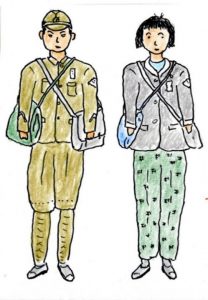Hiroshima document 1945: Student believed mobilization “necessary for winning war”
Aug. 5, 2024
The mobilization of junior high-school students and students at girls’ schools to the central area of Hiroshima City for the work of building demotion to create fire lanes is closely connected to damage from the atomic bombing. According to the Hiroshima Peace Memorial Museum, no photographs recording the circumstances of that work have ever been found. However, Seigo Nishioka, 92, a resident of Hatsukaichi City in Hiroshima Prefecture, has created drawings based on his memories of the experiences and donated the images to the museum.
Starting around May 1945, Mr. Nishioka, then a first-year student at Hiroshima Prefectural Technical High School, was mobilized for building-demolition work in such areas as Fujimi-cho (now part of Naka Ward). After adults on the crew would tear down a house, he and other students used to bind its pillars with rope and pull and gather them for wood. Unable to forget the scene of a woman crying near him as her home was being dismantled, he incorporated that image into one of his drawings.
“At the time, we were taught we should do anything for our country. So, I thought, ‘Why is she crying when we have to do this work to win the war?’ Now, though, I am painfully aware of why the woman was so frustrated and sad,” explained Mr. Nishioka.
One girl living in his neighborhood, Tomoko Yanagawa, then a first-year student at Prefectural Girls’ School, had been mobilized for the same kind of work at a different location in the city. Ms. Yanagawa was a childhood friend with whom he had played house since he was four. He said, “That was a time when it was prohibited for a male junior high-school student and a student at a girls’ school to speak in public.” They would ignore each other while wearing their school uniforms, but after they returned home and changed into ordinary clothes, they would call each other by their familiar names of “Tomo-chan” and “Seigo-chan.”
“When she was wearing a school uniform, Tomo-chan was dazzling to me. She told me she had a hard time finding a restroom at the work site where so many students had gathered,” Mr. Nishioka said. “We spoke about how hard the work of building demolition was.”
On August 6, Ms. Yanagawa was mobilized to the Dobashi area for building-demolition work, the same location where Fujie Yoneda was mobilized. First-year students at Mr. Nishioka’s school were also mobilized for building-demolition work in the city’s downtown, but he happened to be at school due to ill health. That was the difference between life and death for the two childhood friends.
(Originally published on August 5, 2024)
Starting around May 1945, Mr. Nishioka, then a first-year student at Hiroshima Prefectural Technical High School, was mobilized for building-demolition work in such areas as Fujimi-cho (now part of Naka Ward). After adults on the crew would tear down a house, he and other students used to bind its pillars with rope and pull and gather them for wood. Unable to forget the scene of a woman crying near him as her home was being dismantled, he incorporated that image into one of his drawings.
“At the time, we were taught we should do anything for our country. So, I thought, ‘Why is she crying when we have to do this work to win the war?’ Now, though, I am painfully aware of why the woman was so frustrated and sad,” explained Mr. Nishioka.
One girl living in his neighborhood, Tomoko Yanagawa, then a first-year student at Prefectural Girls’ School, had been mobilized for the same kind of work at a different location in the city. Ms. Yanagawa was a childhood friend with whom he had played house since he was four. He said, “That was a time when it was prohibited for a male junior high-school student and a student at a girls’ school to speak in public.” They would ignore each other while wearing their school uniforms, but after they returned home and changed into ordinary clothes, they would call each other by their familiar names of “Tomo-chan” and “Seigo-chan.”
“When she was wearing a school uniform, Tomo-chan was dazzling to me. She told me she had a hard time finding a restroom at the work site where so many students had gathered,” Mr. Nishioka said. “We spoke about how hard the work of building demolition was.”
On August 6, Ms. Yanagawa was mobilized to the Dobashi area for building-demolition work, the same location where Fujie Yoneda was mobilized. First-year students at Mr. Nishioka’s school were also mobilized for building-demolition work in the city’s downtown, but he happened to be at school due to ill health. That was the difference between life and death for the two childhood friends.
(Originally published on August 5, 2024)









